What if I told you there was a leader that 10X’d the market cap of the company he took over, while raising their stock value 1,000%? Would you be interested in their leadership practices?
When Satya Nadella became CEO of Microsoft in February 2014, he brought significant growth and change. This chart tells the story:
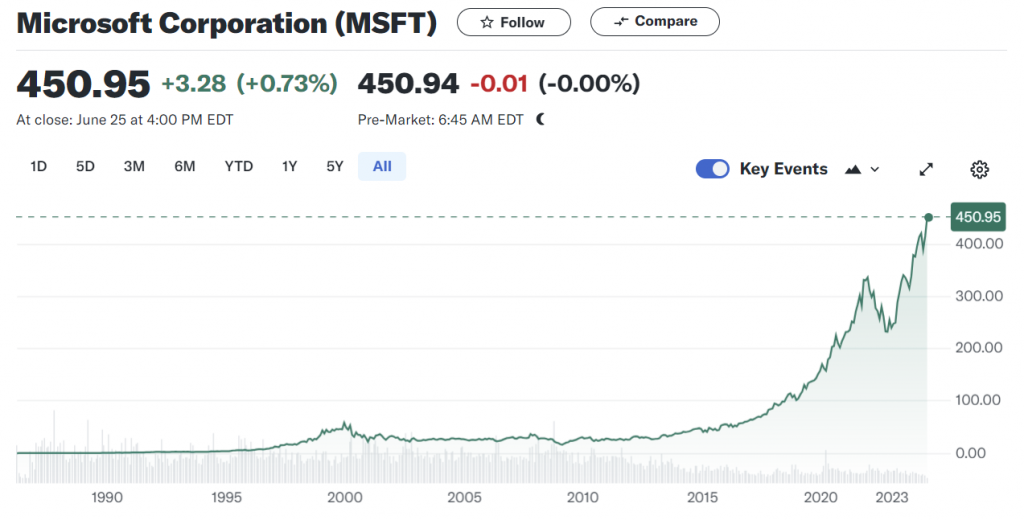
Satya Nadella took over when Microsoft's stock price was about $40, while as of this writing, it's now over $450.
Under Nadella's leadership, Microsoft has acquired major companies (like GitHub and LinkedIn), made huge gains in the emerging AI market (along with the key partnership with OpenAI), and most importantly, changed a toxic culture into one focused on growth and inclusion.
So, what can we learn from a leader who's overseen such a huge turnaround? Today we take a look at 5 key aspects of Satya Nadella's leadership style that have driven this success.
What Lessons can we learn from Satya Nadella's leadership style? Our favorites:
- Define & Share Your Company's Purpose
- Always be listening
- Bring Positive Energy with Emotional Intelligence
- Prioritize Your Culture
- Always be learning
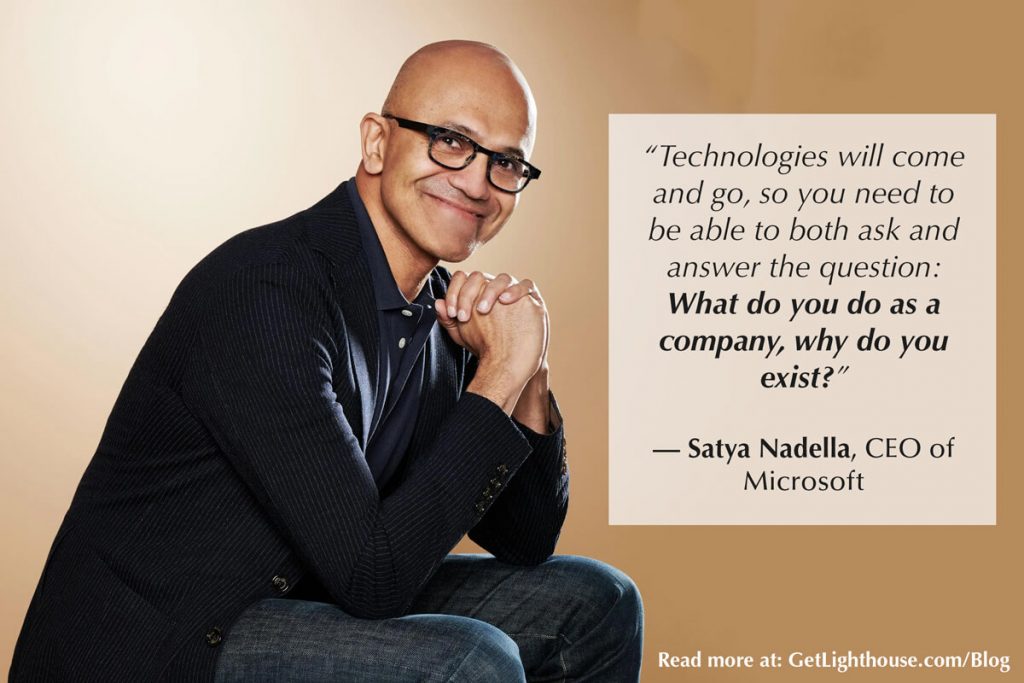
Nadella's Leadership Lesson №1: Define & Share Your Company's Purpose
“Technologies will come and go, so you need to be able to both ask and answer the question: What do you do as a company, why do you exist?”
It's easy to get caught up in the day-to-day hustle of running a business. But Satya Nadella reminds us to take a step back and ask the big question: Why does your company exist?
It's not just about what you do or sell. It's about the purpose that drives your organization.
When you have a clear purpose, it becomes easier to make strategic decisions. Should you launch that new product line? Does that potential partnership align with your goals? Does your marketing campaign fit your why?
Your purpose helps you answer these questions.
A strong sense of purpose can also be incredibly motivating for your team. When people understand the 'why' behind their work, and believe in it, they're more engaged and committed. It's the difference between just punching a clock and feeling like you're part of something meaningful.
Yet, even once you've defined your purpose, the real work has only begun.
It's not enough to just write it down, or put it on a poster. You need to weave it into everything you do. Use it to guide your strategy, your hiring decisions, your marketing messages, and most importantly repeat yourself so that it really sinks in for your team.
Further reading:
- Unlock the secret weapon of effective leadership — the power of repetition. By learning how to use it you can reinforce your company's purpose and key messages. Learn how consistently reinforcing your company's purpose can be the key to your team's buy-in.
- Ask your team these strategic questions to ensure your employees understand and align with your company's purpose.
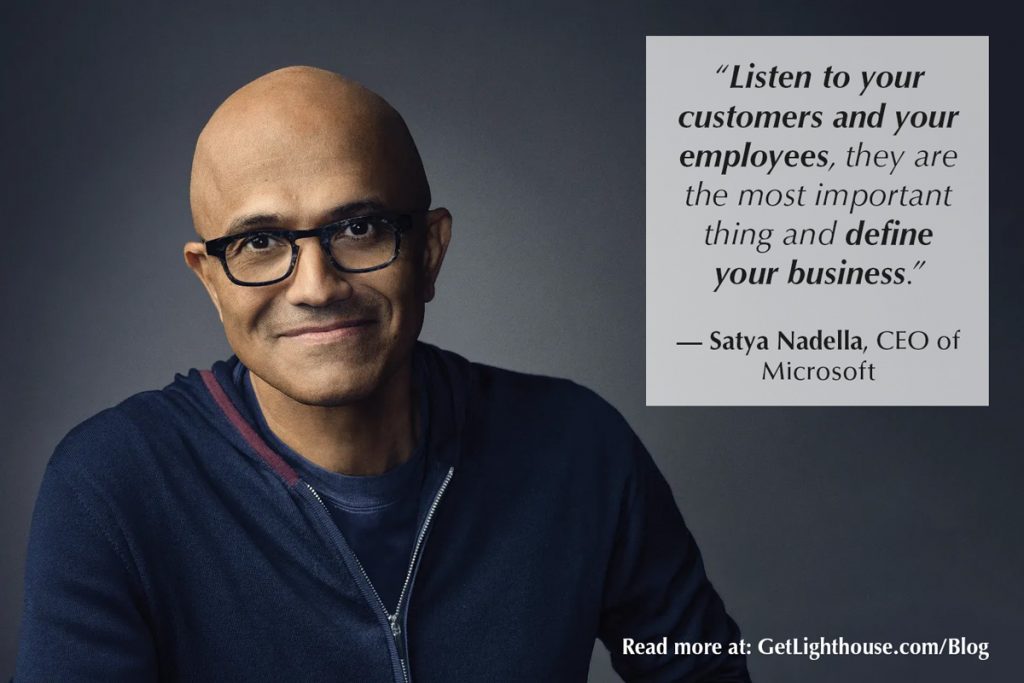
Nadella's Leadership Lesson №2: Always be listening
“Listen to your customers and your employees, they are the most important thing and define your business.”
The answers to your toughest questions don’t come from your imagination. They come from listening to others.
Your customers are the lifeblood of your business. They're the ones using your products or services, and they know better than anyone the problems they have. If you want to maximize the value you create with your business, you need to pay attention to what they’re saying.
And your employees? They're on the front lines every day. They’re communicating with your customers, solving problems, building solutions, and running experiments, all that you may have little or no context on.
That’s why Satya Nadella reminds us we need to listen to both your customers and your employees as much as you can.
Yet, listening isn’t just about uncovering new strategies, ideas, and opportunities. It also has other key benefits.
Listening is a leadership super-power
Making people feel heard is one of the most powerful things you can do.
When customers feel heard, they buy your product, upgrade or expand, and share helpful feedback with your team.
When your employees feel heard, they're more likely to be engaged, loyal, and go the extra mile for you and your customers.
So, how do you become a better listener?
Fortunately, it’s a skill you can learn like any other. At a high level, you’ll need to:
- Ask more questions: Your goal should be to get them talking more than you.
- Pause: Get comfortable with some silence. The best responses often come after a pause in your conversation.
- Actively Listen: Repeat back what you heard in your own words to make sure you understood them.
But here's the best part: the more you listen, the more people will want to talk to you. You'll create a culture of open communication where great ideas can flourish and people feel heard.
Further reading:
- Become a more effective listener with these 5 practical listening techniques that will help you truly hear your customers and employees
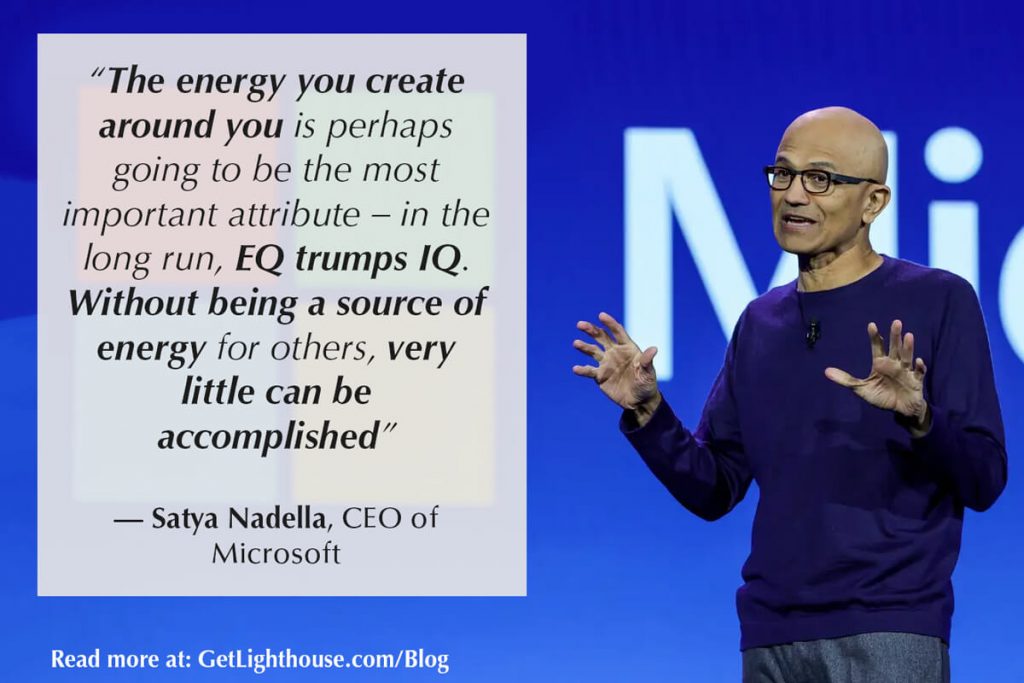
Nadella's Leadership Lesson №3: Bring Positive Energy to Your Team
“The energy you create around you is perhaps going to be the most important attribute – in the long run, EQ trumps IQ. Without being a source of energy for others, very little can be accomplished”
Imagine a great leader. What do you picture? What attributes do they have? What is their personality?
Chances are, they weren't just smart, but also charismatic and energizing.
As you can see, Satya Nadella understands the power of bringing this kind of energy.
Remember: Your mood as a leader is contagious.
If you walk into a meeting radiating stress and negativity, your team will pick up on that. They’re likely to take on a negative tone and mindset, too.
Meanwhile, if you bring enthusiasm and optimism, even in tough times, it can help inspire your team to stay positive, too.
Be positive, but realistic.
Now, this doesn't mean you need to be a cheerleader 24/7. It's about being genuine and emotionally intelligent.
Can you read the room? Do you know how to motivate different types of people? Can you keep your cool when things get heated?
Developing your EQ isn't just a nice-to-have skill - it's crucial for navigating the complex human dynamics in any organization. It helps you build stronger relationships, resolve conflicts more effectively, and make better decisions.
So, how can you work on this?
First, you need to hone and develop your self-awareness. Pay attention to your own emotions and how they affect your behavior. Are you snapping at your team, because you're stressed about a deadline? Does the emotions of one situation bleed into meetings and discussions the rest of the day? Recognizing your own actions and how they impact others is the first step to developing your EQ.
From there, you need to recognize other people’s emotions and how you can positively influence them. If you make it a habit to recognize and appreciate good work, and help resolve any negative issues others have, you may be surprised how it can positively impact your team.
What energy are you bringing to your team?
Further reading:
- Discover how to improve your emotional intelligence and become a better leader by understanding and managing both your own emotions and those of your team.
- Learn about self-awareness, the hardest skill for managers to master, and how developing it can dramatically improve your leadership and team dynamics.
- A great workplace praise guide to learn practical ways to be more positive at work and motivate your team through recognition and appreciation.
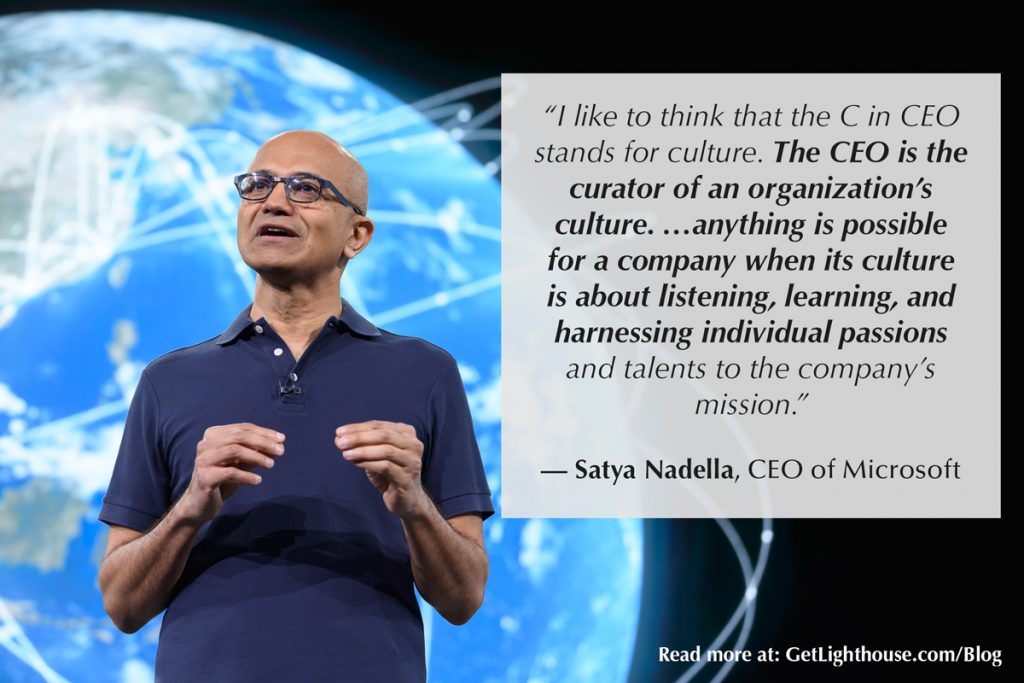
Nadella's Leadership Lesson №4: Put Culture First
“I like to think that the C in CEO stands for culture. The CEO is the curator of an organization’s culture. …anything is possible for a company when its culture is about listening, learning, and harnessing individual passions and talents to the company’s mission.”
Culture isn't about ping pong tables or free snacks. It's about creating an environment where people can do their best work and feel valued.
Think of culture as the personality of your organization. It's what makes your company unique and influences everything from how decisions are made to how people interact with each other. And as a leader, you're the chief architect of your culture.
Good culture is intentional
Every company and team has a culture. You either work hard to make it great, or it’s probably dysfunctional in some way.
It’s not surprising then that Satya Nadella is committed to fostering a positive, healthy culture along with his other leadership tactics.
When people feel aligned with your company's values and mission, they're more engaged and motivated. They will want to go the extra mile for you and your customers, because you’ve gone the extra mile for them.
That’s why it’s important to remember that culture isn't something you state once and you’re done. It's built day by day, decision by decision. If you say you value open communication, but then hide away in your office, or say you care about your team, but then never listen to their needs and requests, you won’t build a good culture.
The right culture can take your company to new heights. Are you doing your part to get your team there?
Further reading:
- Avoid common pitfalls when building your company culture along with strategies to develop a great culture instead.
- Discover the surprising "one key" to building and maintaining a great company culture that goes beyond surface-level perks and truly impacts your team's performance and happiness.
- Learn practical techniques for changing your team's culture to prevent major problems and create a positive work environment that aligns with your company's values and mission.
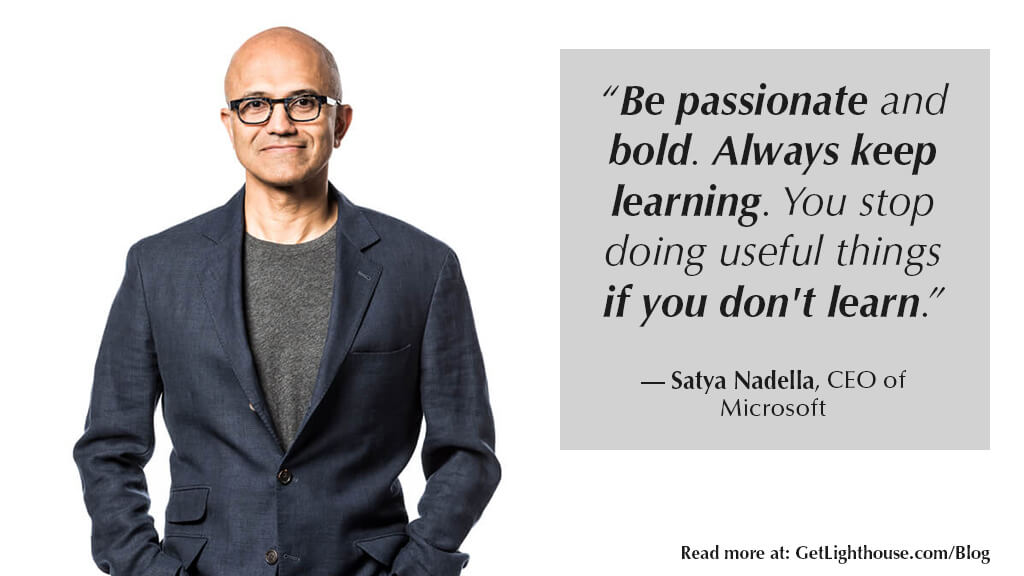
Nadella's Leadership Lesson №5: Always be learning
“Be passionate and bold. Always keep learning. You stop doing useful things if you don't learn.”
It's easy to get caught up in your day-to-day grind and never get around to some of those “I really should” kind of long term investments. But Satya Nadella reminds us that a commitment to your own growth and learning are essential ingredients for success.
It’s also why Satya Nadella mentioned boldness to go with learning. Learning includes having the courage to try new things, and to challenge the status quo when necessary. In a world where change is constant, playing it safe all the time can actually be the riskiest move of all.
The moment you stop learning is the moment you start falling behind.
Learning doesn't always mean something as straightforward as going back to school, signing up for a course, or reading a book. It can also mean measuring a new experiment, empowering your team to share knowledge across your team, or researching unique sources for new inspiration.
Keep in mind: You don’t have to have all the answers.
Encourage your team to be bold as well. Be welcoming and supportive of new ideas. Create psychological safety so people feel safe sharing new learnings and ideas. And support their growth, too (which often can spark new ideas).
Further Reading:
- Explore some of the best career development goals for managers to continually improve your leadership skills and stay ahead in a rapidly changing business environment.
- Learn why prioritizing psychological safety is crucial for developing an innovative team, and discover how to create an environment where team members feel comfortable sharing ideas and taking risks.
Final word
Musk, Jobs, Branson, Cuban. Many famous executives are lionized today.
Yet somehow Satya Nadella has flown under the radar compared to some of his more famous peers. All of this despite the fact that he has had incredible success since taking the helm at Microsoft a decade ago.
As you can see, Nadella believes in many timeless leadership principles that help explain how he has achieved all this success at Microsoft.
Let his example shine a light on the approaches that can work for you, too.





